I don't know if you will find a function or a lib that do that for you. But you can code this rotation by hand.
You don't want to display a real image here, but to print chars that represents a landscape. You have to print the "image" line by line, but since your landscape array represents the number of '#' you want in each column, you have to loop over the total number of lines you want, and for each char in that line, print a ' ' or a '#' depending on the corresponding landscape column value
With
h = max(landscape)
you calculate the total number of lines you want to print by finding the max of the landscape values.
Then, you loop over theses lines
for line in reversed(range(h)):
in that loop, line takes values 6, 5, 4, etc.
For each line, you have to loop over the whole landscape array to determine, for each column if you want to print a space or a '#', depending on the value of the landscape column (v) and the current line
for v in self.landscape:
self.image += ' ' if line >= v else '#'
The full program:
class Reservoir:
def __init__(self, landscape):
self.landscape = landscape
h = max(landscape)
self.image = ''
for line in reversed(range(h)):
for v in self.landscape:
self.image += ' ' if line >= v else '#'
self.image += '\n'
landscape = [4, 3, 2, 2, 1, 1, 0, 0, 0, 0, 0, 0, 0, 1, 1, 2, 5, 6, 5, 2, 2, 2, 3, 3, 3, 4, 5, 3, 2, 2]
lake = Reservoir(landscape)
print(lake.image)
The result:
#
### #
# ### ##
## ### ######
#### ###############
###### #################
